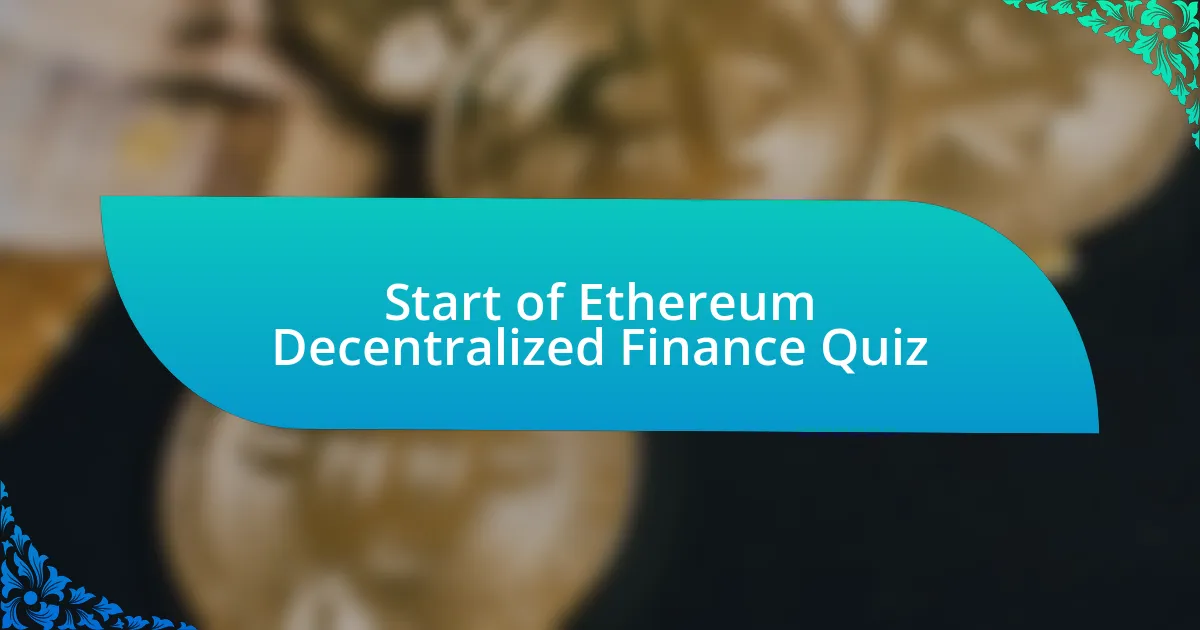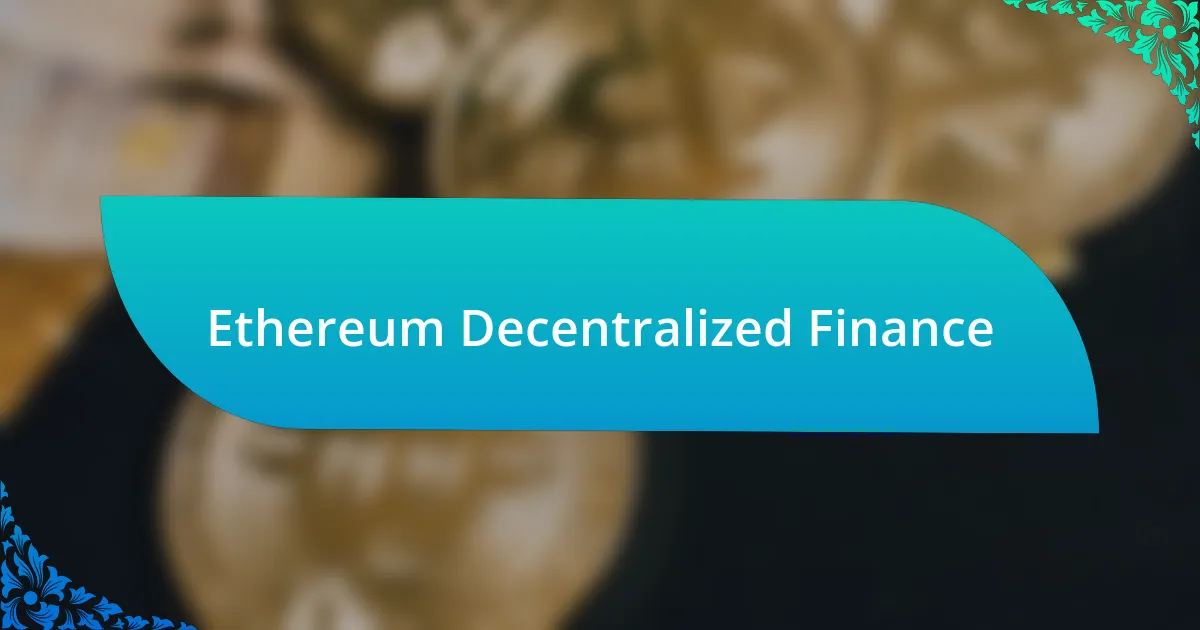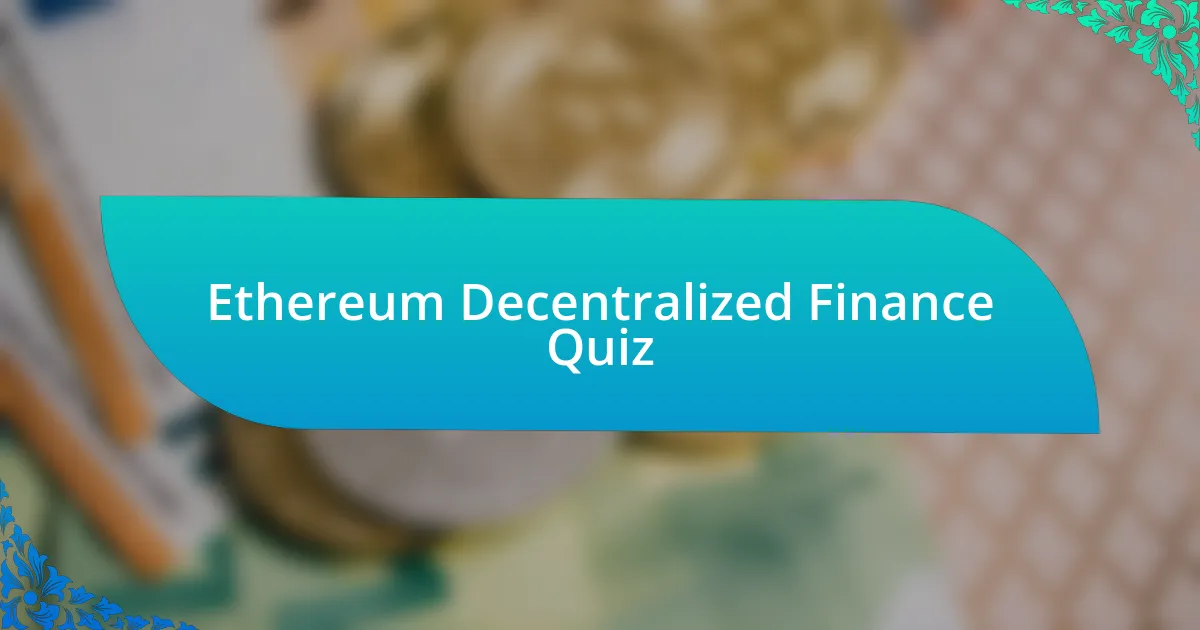
Start of Ethereum Decentralized Finance Quiz
1. What is a key characteristic that differentiates DeFi from traditional finance?
- Holding assets in a central institution
- Offering physical cash for transactions
- Increasing bank fees for users
- Removing third parties from transactions
2. How do decentralized exchanges (DEXs) facilitate trading without intermediaries?
- Decentralized exchanges (DEXs) use smart contracts for trading directly between users.
- Decentralized exchanges (DEXs) operate through centralized servers to facilitate trades.
- Decentralized exchanges (DEXs) require banks to verify all transactions.
- Decentralized exchanges (DEXs) use physical cash to settle trades.
3. What is the primary use of smart contracts in DeFi applications?
- Creating digital artworks for online galleries
- Developing video games with in-game purchases
- Automating financial transactions such as lending, borrowing, and trading without intermediaries
- Managing personal finances through traditional banks
4. What mechanism allows DEX aggregators to improve trading efficiency?
- Centralized control
- Liquidity aggregation
- Fixed trading fees
- Manual order matching
5. What is the crucial role of liquidity providers in the DeFi ecosystem?
- Managing customer relationships for financial institutions.
- Ensuring all transactions are reversible for security.
- Providing liquidity for trading on decentralized exchanges.
- Collecting fees from traditional banks for services.
6. How do users interact with Ethereum-based decentralized applications (dApps)?
- By calling a hotline to place orders.
- By mailing physical forms for transactions.
- By using a digital wallet to sign transactions.
- By meeting in person with a broker.
7. What term describes the risk of asset value fluctuations for liquidity providers?
- Credit risk
- Operational risk
- Impermanent loss
- Market risk
8. In Ethereum, what is the function of the proof of stake consensus mechanism?
- Validating transactions and creating new blocks
- Storing user data securely
- Trading cryptocurrencies directly
- Preventing hacks and attacks
9. How does DeFi enhance financial inclusivity compared to conventional banking?
- DeFi enables accessible financial services globally without the need for traditional banks.
- DeFi eliminates the need for digital currencies in financial transactions.
- DeFi limits access to financial services based on geographical restrictions.
- DeFi requires users to have extensive financial knowledge to participate effectively.
10. What is the benefit of using stablecoins in the DeFi landscape?
- Stability during market volatility
- Central control over funds
- Exclusivity to wealthy investors
- High transaction fees
11. Can DeFi protocols function without centralized authority?
- No, they need a central exchange to process transactions.
- Yes, but only with government regulations.
- Yes, DeFi protocols can function without centralized authority.
- No, they rely on banks to operate.
12. What is the concept of `yield farming` in DeFi?
- Yield farming means trading cryptocurrencies on centralized exchanges.
- Yield farming refers to earning rewards by providing liquidity to DeFi protocols.
- Yield farming is the process of buying and holding NFTs for profit.
- Yield farming involves investing in traditional stocks and bonds.
13. How does impermanent loss affect users providing liquidity in DeFi?
- Users receive guaranteed income no matter the market changes.
- Users are always compensated for liquidity provision with ETH rewards.
- Users face no financial risks when providing liquidity in DeFi.
- Users may experience reduced earnings due to price fluctuations.
14. What is one major security concern within DeFi projects?
- Security risks and hacks
- High transaction fees
- Slow transaction speeds
- Limited liquidity options
15. What is the function of governance tokens in decentralized platforms?
- Governance tokens allow holders to participate in decision-making for decentralized platforms.
- Governance tokens are used to mine new cryptocurrencies on the network.
- Governance tokens serve as rewards for liquidity providers only.
- Governance tokens enable users to trade cryptocurrencies with lower fees.
16. What is the Ethereum network primarily used for in the context of DeFi?
- Making peer-to-peer financial transactions
- Issuing traditional loans
- Storing digital art assets
- Creating centralized exchanges
17. How does Ethereum`s Gas mechanism influence DeFi transactions?
- Gas fees determine transaction costs and speed in DeFi.
- Gas fees are fixed and do not vary with network demand.
- Gas fees only affect token prices and nothing else.
- Gas fees are unrelated to transaction times in DeFi.
18. What kind of solutions do oracles provide in the DeFi space?
- Price feeds
- Centralized exchanges
- Traditional banking
- Government regulations
19. What sets automated market makers (AMMs) apart from traditional exchanges?
- AMMs operate solely on physical exchanges.
- AMMs require a central authority to operate.
- AMMs rely on fixed prices set by brokers.
- AMMs use liquidity pools to set prices.
20. What is the role of flash loans in decentralized finance?
- Flash loans allow users to borrow assets without collateral for a short time.
- Flash loans are only available for long-term investments and loans.
- Flash loans require a credit check before borrowing funds.
- Flash loans are exclusive to centralized finance institutions only.
21. How does the Ethereum Virtual Machine (EVM) support DeFi applications?
- It requires intermediaries to process transactions on behalf of users.
- It encrypts transactions to enhance user privacy and security.
- It regulates all financial markets directly from the Ethereum blockchain.
- It allows decentralized applications to execute smart contracts and manage transactions seamlessly.
22. What is a common challenge faced by decentralized exchanges?
- Slow transaction processing
- Low liquidity
- High transaction fees
- Limited user base
23. How is the concept of trust minimized in DeFi platforms?
- By requiring user identification for transactions.
- By centralizing transaction processes.
- By using traditional banking methods.
- By eliminating intermediaries like banks.
24. What defines the liquidity crunch in decentralized finance?
- A sudden decrease in the availability of liquidity in DeFi markets.
- A rise in stablecoin pegging failures.
- The permanent locking of user funds in smart contracts.
- An increase in trading volume across all platforms.
25. What are the advantages of composable protocols in DeFi ecosystems?
- Permissionless composability
- Centralized control
- Limited access to assets
- High transaction fees
26. How do decentralized lending protocols mitigate borrower risks?
- They employ centralized authorities to manage risks.
- They use collateral requirements to offset potential losses.
- They charge high-interest rates to mitigate losses.
- They rely solely on credit scores for loan approval.
27. What is the significance of collateralization in DeFi lending?
- It eliminates all transaction fees associated with borrowing.
- It guarantees instant loan approvals regardless of credit history.
- It ensures loans are secured by assets, reducing lender risk.
- It allows borrowers to bypass all repayment obligations.
28. What type of community mechanisms are typically employed by DeFi projects?
- Personal loans
- Governance tokens
- Fixed deposits
- Traditional savings accounts
29. How can Ethereum-based DeFi applications ensure transparency?
- By providing a transparent and immutable record of transactions on the blockchain.
- By storing transaction data in a centralized server for easy access.
- By encrypting transactions so only select parties can see them.
- By allowing users to obscure their transaction histories.
30. What is the impact of regulatory developments on the DeFi landscape?
- Regulatory clarity can streamline DeFi operations and attract institutional investors.
- Regulatory developments eliminate the need for blockchain technology in DeFi.
- Regulatory changes make DeFi platforms completely centralized.
- Regulatory barriers increase transaction fees for all DeFi users.

Congratulations! You Have Successfully Completed the Quiz
Completing the quiz on Ethereum Decentralized Finance (DeFi) is a significant achievement. It has likely expanded your understanding of how Ethereum operates within the DeFi ecosystem. You might have learned about smart contracts, liquidity pools, and decentralized exchanges. These concepts are crucial for anyone interested in the future of finance.
Your engagement with the quiz reflects a curiosity about the evolving world of digital finance. Learning how Ethereum supports innovative financial solutions is both exciting and important. Each question pushed you to think critically about the potential and challenges of DeFi. We hope you found the experience enjoyable and informative.
To further enhance your knowledge, we invite you to explore the next section on this page. There, you will find more in-depth information about Ethereum Decentralized Finance. This additional material will help solidify what you’ve learned and expose you to new ideas and trends. Dive in and continue your journey into the world of DeFi!

Ethereum Decentralized Finance
Understanding Ethereum and Its Role in Decentralized Finance
Ethereum is a blockchain platform that enables developers to create decentralized applications (dApps). It introduced smart contracts, self-executing contracts coded with terms directly in the blockchain. This functionality is the foundation of Decentralized Finance (DeFi), which offers financial services without intermediaries. Ethereum’s robust ecosystem supports various DeFi projects, enhancing accessibility and transparency in financial transactions.
The Components of Ethereum Decentralized Finance
Ethereum DeFi comprises key components such as lending platforms, decentralized exchanges (DEXs), and stablecoins. Lending platforms allow users to borrow against crypto assets, while DEXs facilitate peer-to-peer trading without central authorities. Stablecoins, pegged to fiat currencies, provide stability amidst the volatility of cryptocurrencies. These components interact seamlessly within the Ethereum network, creating a holistic financial ecosystem.
The Benefits of Using Ethereum for Decentralized Finance
Using Ethereum for DeFi offers several advantages: increased transparency, reduced costs, and greater accessibility. Transactions are recorded on a public ledger, ensuring transparency. The elimination of intermediaries reduces fees, making financial services more affordable. Additionally, anyone with internet access can participate in DeFi, promoting financial inclusion globally.
Challenges Facing Ethereum Decentralized Finance
Despite its benefits, Ethereum DeFi faces challenges such as scalability, security vulnerabilities, and regulatory scrutiny. Network congestion can lead to slow transaction times and high fees. Security issues like smart contract bugs can expose users to financial loss. Furthermore, as DeFi grows, it attracts the attention of regulators concerned about consumer protection and market integrity.
Future Trends in Ethereum Decentralized Finance
The future of Ethereum DeFi is likely to be shaped by innovations in layer 2 solutions and cross-chain interoperability. Layer 2 solutions aim to improve transaction speed and reduce costs by processing transactions off the main Ethereum chain. Cross-chain interoperability would enable seamless transactions across various blockchain networks, expanding DeFi functionality and user base. Together, these trends could significantly enhance the efficiency and reach of Ethereum DeFi.
What is Ethereum Decentralized Finance?
Ethereum Decentralized Finance (DeFi) refers to a suite of financial services offered on the Ethereum blockchain without the need for traditional intermediaries like banks. It includes lending, borrowing, trading, and earning interest on digital assets through smart contracts. As of October 2023, the total value locked in Ethereum DeFi projects surpassed $40 billion, illustrating the growing adoption of these services.
How does Ethereum Decentralized Finance work?
Ethereum DeFi operates through smart contracts, which are self-executing contracts with the terms directly written into code. Users interact with decentralized applications (dApps) to perform financial transactions. For example, lending platforms allow users to provide liquidity in exchange for interest through automated market makers (AMMs). The security and transparency of transactions are ensured by the Ethereum blockchain.
Where can you find Ethereum Decentralized Finance applications?
Ethereum Decentralized Finance applications can be found on specific DeFi platforms and dApps, such as Uniswap, Aave, and Compound. These platforms are accessible through web browsers and wallets that support Ethereum. They allow users to easily engage in activities like trading, lending, and staking cryptocurrencies.
When did Ethereum Decentralized Finance begin to gain popularity?
Ethereum Decentralized Finance began to gain significant popularity in 2020, commonly referred to as the “DeFi Summer.” During this period, numerous projects emerged, and total value locked in DeFi surged from under $1 billion in early 2020 to over $10 billion by mid-2020, highlighting the rapid growth in user interest and participation.
Who are the key players in Ethereum Decentralized Finance?
Key players in Ethereum Decentralized Finance include major protocols such as MakerDAO, Uniswap, Aave, and Compound. Additionally, developers and liquidity providers are crucial to the ecosystem. Collectively, these entities contribute to the building, maintaining, and utilizing DeFi services on the Ethereum platform.

